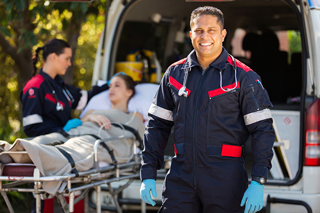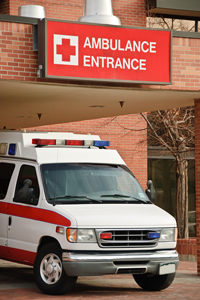Paramedic / EMT Training Schools
Last Updated
By taking paramedic or EMT classes near you, you'll be one step closer to enjoying an exciting, meaningful, and reliable career.
Do you have a take-charge personality? Are you calm, cool, and collected—even under challenging circumstances? You may be a perfect candidate for paramedic or emergency medical technician (EMT) training. Education can equip you with what it takes to be on the scene at emergencies and care for people before they make it to the hospital.
The paramedic or EMT training near you will probably involve a lot of practical skills development. Among many other varied subjects, you're likely to learn about emergency scene operations, rescue breathing, shock trauma assessment, and intravenous therapy. It's all aimed at helping you become one of the well-trained heroes who get to serve on the front lines of medical emergencies.
So get the quick training that can help you make a career out of saving lives. Discover paramedic or EMT courses near you by putting your current zip code into the following school finder!
EMT and Paramedic Schools
Sponsored Listings
Columbia Southern University
- Online
- Health Care Administration - Emergency Medical Services
- Emergency Medical Services Administration - Emergency Medical Services Education
EMT and Paramedic Career Information
 Accidents happen. People get sick. Life is fragile. When life-and-limb emergencies occur, we hope that heroes will be there to save us. So it takes real guts to step up and be one of those heroes. The emergency medical technicians (EMTs) and paramedics who work on the front lines of medical crises are part of a rapidly evolving industry that is crucial to our peace of mind. Every day, countless lives depend on the quick reaction and skillful care of those who work in the field of emergency medical services (EMS).
Accidents happen. People get sick. Life is fragile. When life-and-limb emergencies occur, we hope that heroes will be there to save us. So it takes real guts to step up and be one of those heroes. The emergency medical technicians (EMTs) and paramedics who work on the front lines of medical crises are part of a rapidly evolving industry that is crucial to our peace of mind. Every day, countless lives depend on the quick reaction and skillful care of those who work in the field of emergency medical services (EMS).
Without people who've been trained to come to our rescue when tragedy strikes, many of us would not survive medical emergencies. After all, an emergency can strike us anywhere, at anytime. That's why attending an EMT or paramedic school near you can have such a positive and powerful impact on both your own life and the lives of other people in your community.
Paramedics and emergency medical technicians are first responders who specialize in pre-hospital medical care.
EMT vs. Paramedic: What Is the Difference?
There are several different levels of first responders in the field of emergency medical services.
The first thing you should know is that a paramedic is an emergency medical technician (EMT), but an EMT is not necessarily a paramedic. This is because the term "paramedic" is reserved only for those who are certified at the highest level of pre-hospital emergency care.
Here are some other key points to understand:
- In most states, there are two levels of EMT certification: (1) EMT-Basic and (2) EMT-Paramedic. A few states also include a level between these known as EMT-Intermediate.
- Those with EMT-Basic or EMT-Intermediate certification are generally just referred to as EMTs or ambulance technicians.
- Those with EMT-Paramedic certification are referred to as paramedics (or "medics" for short).
- EMTs with basic certification have generally undergone about 120 to 200 hours of training. In contrast, paramedics have usually had from 1,200 to 1,800 hours of training (often resulting in a two-year associate degree).
- Because paramedics have much more extensive training than basic or intermediate EMTs, they are allowed to perform a much wider range of tasks. In most states, for example, those with EMT-Basic certification are not allowed to give shots or start intravenous lines. Paramedics, on the other hand, can provide more advanced supportive care, such as giving shots, starting IVs, and administering medications.
- Regardless of their certification level, all EMTs can respond to emergency medical incidents, resuscitate patients, and provide basic life support to patients during transfers to or between hospitals or other medical facilities.
Don't hesitate to contact an EMT school near you to learn more about how EMTs and paramedics may differ in your specific region.
Job Description
Emergency medical technicians can have a wide range of responsibilities depending on their level of training and certification, where they work, and what happens on any given day. Still, just about all EMTs share some common duties.
A day in the life can include general tasks such as:
- Responding to emergency calls from a 911 operator or dispatcher
- Assessing scenes of emergency along with the conditions of sick or injured patients
- Cooperating with any police or firefighters at the scene of an emergency
- Determining the proper course of emergency medical treatment for patients
- Performing appropriate emergency medical assistance like CPR, wound bandaging, and airway management
- Using backboards and restraints, if necessary, in order to ensure that patients remain safe and still during ambulance rides
- Calling ahead to hospital emergency departments to give them advanced information about patient conditions and to receive any necessary instructions
- Transporting patients to hospital emergency departments via ambulance while monitoring their vital signs and providing any necessary care
- Communicating all observations and carried-out treatments to emergency department personnel
- Documenting all emergency medical care given to patients
- Checking over and cleaning used equipment
- Replacing any supplies that have been used
- Reporting patients with infectious diseases to the appropriate authorities and decontaminating the ambulances they were transported in
- Transferring patients between different medical facilities
The specific tasks related to patient care that EMTs are allowed to carry out vary a lot from state to state and also depend on certification level. A typical paramedic job description will include many more allowable tasks than one for a basic or intermediate EMT. In general, though, patient care duties tend to break down this way:
- EMTs with basic certification can assess patients' conditions, engage in non-invasive medical interventions, and manage their patients' respiratory, cardiac, and trauma emergencies by using basic life-support techniques.
- EMTs with intermediate certification can do all of the above plus administer intravenous fluids and a limited set of medications.
- Paramedics can do all of the above plus administer a wider range of medications and intravenous fluids, interpret EKGs to monitor heart function, and use a greater variety of other monitors and complex equipment. Some paramedics are even specially trained to work as part of a helicopter flight crew for saving the most critically ill or injured patients.
Look into the EMT and paramedic programs near you to find a school that can help you learn even more about the rewarding day-to-day duties of people in the EMS field.
Work Environment
The most common employers are private ambulance services, followed by local governments and hospitals.
Most work full-time in metropolitan areas. The nature of their work is such that they must do their jobs in both indoor and outdoor environments.
Typical Salary
Wages depend a lot on certification level, amount of experience, type of employer, and geographic location. However, based on Occupational Outlook Handbook (OOH) data from May 2022, yearly median wages break down like this:*
- Emergency Medical Technicians: $36,680
- Paramedics: $49,090
In many cases, you can expect the typical paramedic salary to fall closer to the middle and higher end of the above estimates since paramedics must have more advanced training and certification than a basic EMT.
Requirements
The emergency medical services (EMS) industry can be complicated. Different rules exist in each state and, in some cases, each city or county. So the specific EMT requirements you need to know about must be obtained by contacting your state's EMS office (or the EMS office of the state you intend to work in if it is different from where you currently reside). The EMT schools near you can probably also tell you about the requirements in your region.
In most states, you will have to complete a certified training program and then pass a national certification exam administered by the National Registry of Emergency Medical Technicians (NREMT). The exam consists of both written and practical (hands-on demonstration) components.
Obtaining NREMT certification is usually enough to qualify you for state licensure; however, a few states have their own certification exams and may also use different terminology to describe those within the EMS profession.
NREMT certification is awarded at different levels depending on your training and exam:
- EMT-Basic
- EMT-Intermediate
- Paramedic
Job Benefits
Here are some of the most common benefits of completing an EMT program near you and working in the EMS field:
- High personal satisfaction—Professional rewards don't get much better than the deep feeling of meaningful contribution that comes from helping to save other people's lives.
- Changes in scenery—EMTs are frequently on the move from location to location, so variety is built into this occupation.
- Interesting challenges—You will consistently be faced with new challenges, keeping your work life interesting.
Advancement Opportunities
Generally speaking, most EMTs advance in their careers by earning more certifications to handle a wider range of emergency situations.
With experience and additional training, EMTs and paramedics can advance into management roles or become flight paramedics. Opportunities also exist in emergency dispatch services and teaching.
Some choose to make lateral career moves into special operations, hazardous materials, or public education units.
Job Outlook
The employment outlook is bright. In fact, projections data from the Bureau of Labor Statistics indicates that employment in this field is expected to grow by five percent from 2022 to 2032.*
Much of that growth is due to the increase in the population of the middle-aged and elderly, which is likely to result in more medical emergencies from heart attacks, strokes, and other common traumas. In addition, EMTs will be needed for transferring patients to specialized medical facilities, which are expected to increase in number.
How to Become an EMT
The most common path involves:
- Ensuring that you have at least a high school diploma or equivalent
- Obtaining certification in CPR (cardiopulmonary resuscitation)
- Finding an EMT school near you that offers a formal EMT-Basic training program that meets or exceeds the standards of the National Standard Curriculum
- Successfully completing your formal training, which is generally about 120 to 200 hours
- Obtaining licensure in your state, which usually involves passing the NREMT's national basic certification exam
- Getting additional training (usually about 8 hours) and licensure for ambulance driving if that is something you want to be able to do
Here are some other points to keep in mind:
- In some states, you have the option of obtaining Intermediate certification, which usually requires about 1,000 of formal training.
- Before you decide to enroll in your training, it's a great idea to see if any of your local EMS services have a ride-along program. You might be able to spend several days with actual EMTs and paramedics to get a real feel for the profession.
- New EMTs often decide to volunteer for hospitals or community ambulance services to start building their resumes.
- In many popular regions, private ambulance services and medical facilities require at least two years of experience. So, at the beginning of your career, you may need to keep an open mind about relocating to a region where you can get that experience.
How to Become a Paramedic
In most cases, this career path involves:
- Obtaining basic EMT (or higher) certification (see the section above)
- Finding paramedic schools near you and choosing a formal paramedic training program that meets or exceeds the standards of the National Standard Curriculum
- Successfully completing your training, which is usually about 1,200 to 1,800 hours (taking up to two years)
- Obtaining state licensure, which, in most states, involves passing the NREMT's Paramedic certification exam.
Duration of Training
The amount of time schooling takes can vary depending on the program you choose. Still, the length of most programs fall within a similar range.
Basic training usually takes from about three to seven months to complete.
Intermediate training will usually take somewhere around one to two years.
Most paramedic associate degree programs are designed to take about two years to complete. Certificate programs can take less time than this.
What You Can Learn
Although they can vary a little from school to school, most training programs follow the National Standard Curriculum from the United States Department of Transportation's National Highway Traffic Safety Administration (NHTSA).
Most basic EMT programs require you to have CPR certification prior to getting started. The typical EMT curriculum consists of subject areas such as:
Theory and Administration
- Medical, legal, and ethical issues
- General pharmacology
- Basic concepts of emergency medical care
- Interpersonal and emergency communications
- Writing documentation reports
Human Anatomy and Body Systems
- Baseline vital signs
- Airway anatomy, physiology, equipment, and procedures
- Overview of the human body
Practical Patient Care
- Detailed physical exams of patients
- Bleeding and shock
- Head and spinal injuries
- Soft tissue injuries
- Musculoskeletal care
Emergency Care
- Basic overviews of triage, mass casualty situations, incident management systems, and hazardous materials
- Ambulance operations
- Allergic reactions
- Poisoning and overdose
- Respiratory, cardiovascular, diabetic, environmental, and obstetric emergencies
- Emergency care for children and infants
In terms of paramedic training, some programs require you to complete prerequisite courses in anatomy and physiology before being admitted.
By enrolling in a program, you can expect the same types of courses as those listed above, but you can also expect a more in-depth curriculum that is split into three main components: (1) classroom instruction, (2) skills laboratories, and (3) supervised clinical rotations in real EMS field and hospital environments.
The paramedic classes near you are likely to include extensive coursework in subject areas such as:
Theoretical Concepts and Healthcare Administration
- Medical, legal, and ethical issues
- Pharmacology
- Taking a patient's medical history
- Clinical decision making
- Written documentation
- Assessment-based management
Human Anatomy, Physiology, and Body Systems
- General pathophysiology
- The pulmonary system
- Cardiology
- Neurology
- Gastroenterology
- Endocrinology
- Gynecology and obstetrics
- Neonatology
- Toxicology
- Hematology
- Infectious diseases
- Psychiatric and behavioral disorders
Hands-On Care
- Illness and injury prevention
- Pediatric issues
- Geriatric issues
- Administering intravenous medications
- Airway management and ventilation
- Physical examination techniques
- Acute interventions for chronic care patients
Emergency Care and Procedures
- Ambulance operations
- Rescue operations
- Crime scene awareness
- Hazardous materials incidents
- Emergency communications
- Trauma systems and mechanisms of injury
- Soft tissue trauma
- Hemorrhage and shock
- Head and facial trauma
- Spinal trauma
- Burns
- Abdominal and thoracic traumas
- Musculoskeletal trauma
- Urology and renal issues
How Can I Find Paramedic and EMT Classes Near Me?
It's easy. All it takes is a quick search using the program finder below. Just enter your zip code to discover great options for paramedic or EMT training near you!
* Bureau of Labor Statistics, U.S. Department of Labor, Occupational Outlook Handbook. Some careers listed may be part of a combined occupation profile (visited August 28, 2023).



